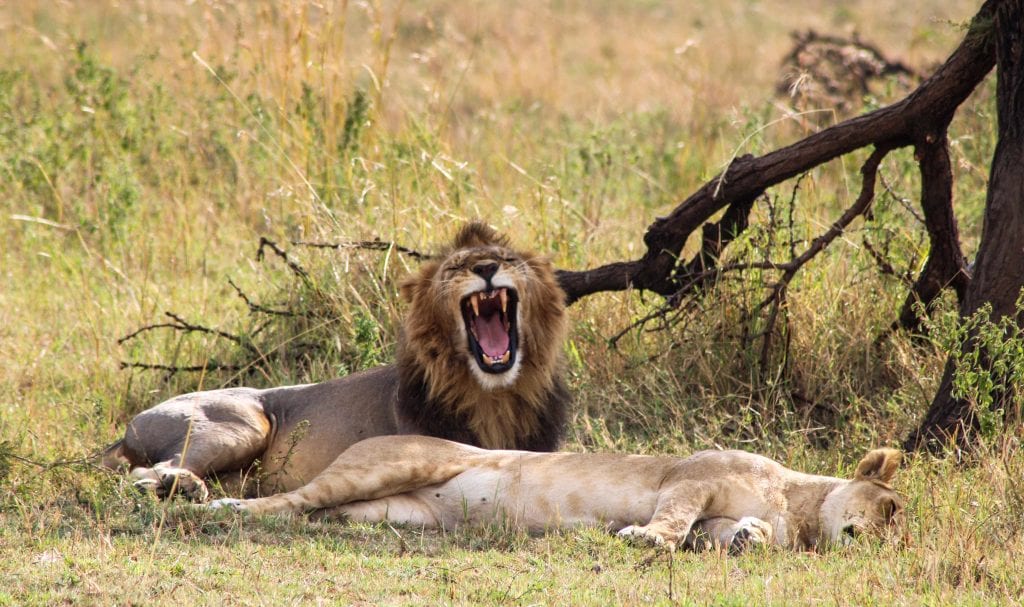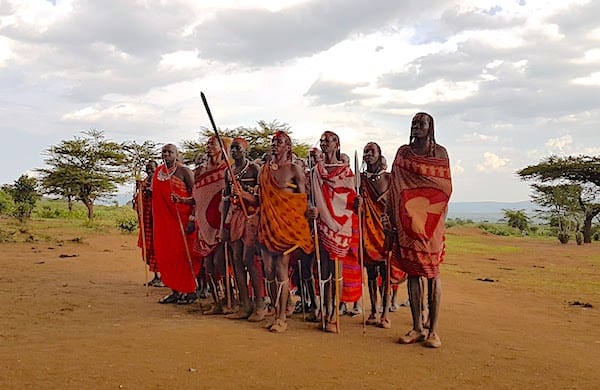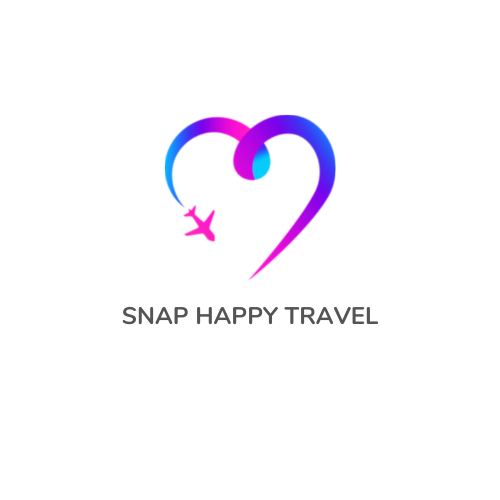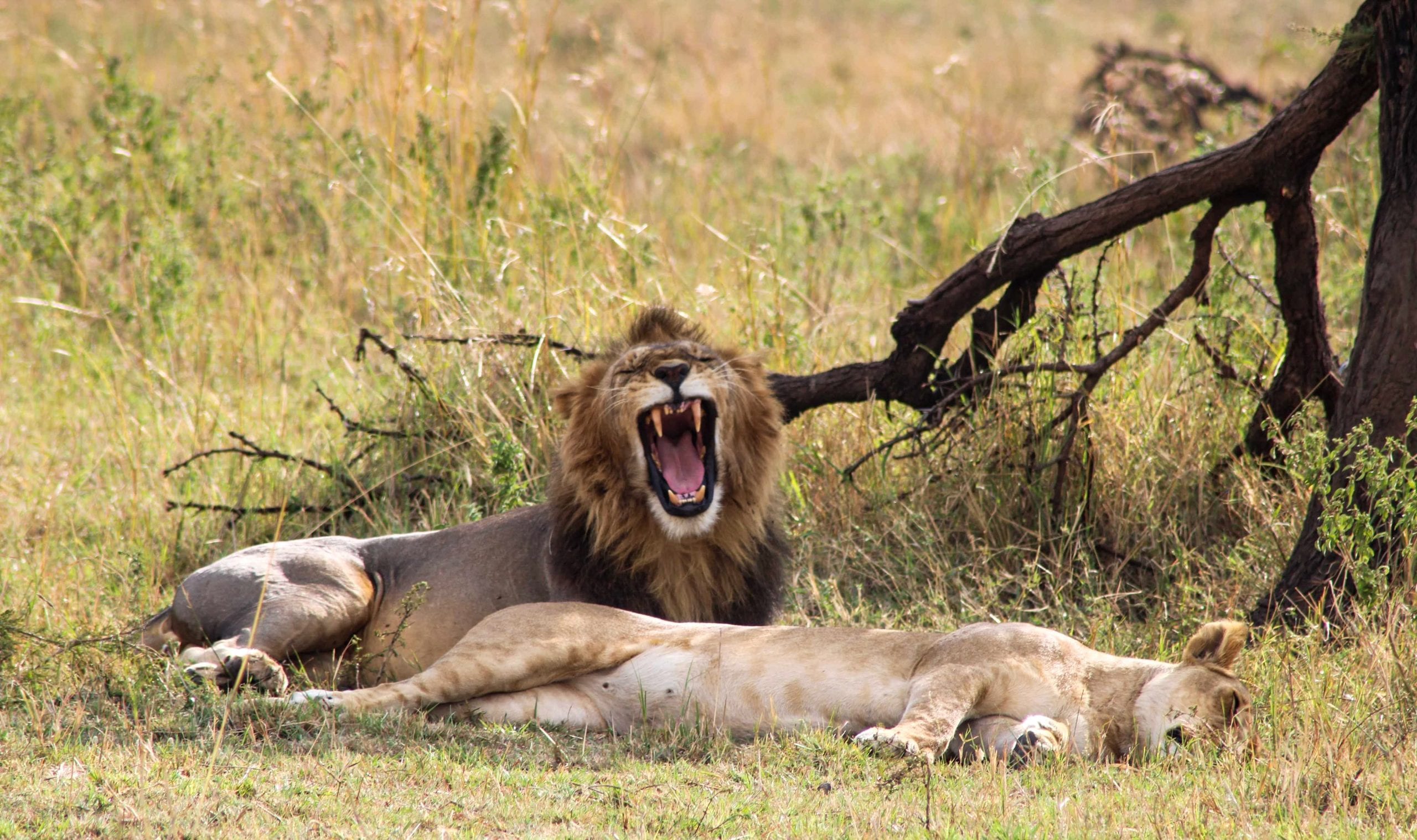In this blog post, we’ll tell you all about our honeymoon in Serengeti. Where we stayed, what we ate and what animals we saw.
Not only were we lucky enough to get married in Cinque Terre, Italy this past August. We were also incredibly lucky to have a month long honeymoon in Africa afterwards. A once-in-a-lifetime trip that can only really be justified for a big occasion like your honeymoon. It trully was everything we imagined it would be and no activity left us disappointed.
A big part of this trip was spending three nights in the unforgettable Serengeti. This was a very exciting moment for me having spent many years watching TV shows about the Serengeti on National Geographic. In this blog post we will let you in on a few secrets about our trip to Serengeti – where we stayed, how we got there and what months are the best for wildlife viewing!

Where we stayed in Serengeti on our Honeymoon
In total, we spent three nights in the Serengeti and the surrounding area (including Ngorongoro Crater National Park). Our first two nights here were spent in Lobo Wildlife Lodge in the Lobo area of the park. This is a government-owned lodge that was built back in 1968.
It has a beautiful setting overlooking the park, but it needs some maintenance. The floorboards in our room were very squeaky. But the view from the deck area of the bar and the pool more than made up for the minor quirks. We stayed on a full board package, and the food was good, although not as good as some other Lodges we stayed at.

For our third night we stayed at Ngorongoro Wildlife Lodge (you can book the luxurious Ngorongoro Serena Lodge which is nearby here). This is located within the Ngorongoro Crater National Park and is approximately 3 hours drive from the exit gate of Serengeti.
The Lodge has a fantastic view from the main deck of the crater, when we arrived we even spotted a black rhino through the Lodges’ binoculars from here. Like Lobo Wildlife Lodge, this Lodge is government-owned but seems more modern (recently renovated, perhaps). It was built in 1969. Again, we stayed on a full board package and the food here was of really high quality.
This 3-day 2-night tour is very similar to the tour we did in Serengeti!

Where to Stay in Serengeti National Park
Other than the two hotels we stayed at, there are several hotels we recommend to stay in Serengeti. Which one you choose depends on your budget ( a lot are $$$ as you can imagine) and what part of the National Park you want to stay in (Serengeti is huge!!). Here I have split the hotels into three of the most popular areas – Seronera; Naabi Hill and Mara River.

Seronera
Also known as the Central Serengeti, this is the best part of the Park to see big cats like lions, cheetahs and leopards. The peak season in the Seronera is between April and June and October to December – when the Great Migration passes through the area. These months are definitely the best time of year to go on safari in Tanzania! Seronera airstrip (where we flew into from Zanzibar) is also located here.
Best hotels in Seronera – Mbuzi Mawe Serena Camp; Four Seasons Serengeti and Siringit Serengeti
Mara River
The Mara River borders both Kenya and Tanzania, this area in Serengeti is famous because it is where the Great Migration happens (we witnessed it and it was amazing!!). As a result this area gets booked up quickly from September to December when the great migration happens in the area.
Best hotels near Mara River – Melia Serengeti Lodge; Serengeti Serena Lodge and Mbalageti Serengeti
Naabi Hill
This is where the main gate to enter Serengeti is located so it’s a popular option for the first night in Serengeti. Naabi Hill is actually an acacia-covered hill and this area is home to lions and the Great Migration passes through the area on the way to the Eastern Serengeti.
Best hotels in Naabi Hill – Gnu Ndutu Camp and Lake Ndutu Luxury Tented Camp
How We Got to the Serengeti

We arrived to the Serengeti in a very unique and memorable way – by fixed wing plane. We booked with Auric Air from. Zanzibar to Seronera airstrip in the Serengeti. This included a quick re-fuel in Arusha. This was an amazing experience, flying high over the blue Indian ocean, and above the Serengeti in a small plane. Our plane only sat 9 passengers plus the pilot and co-pilot.

Neither Paul nor I are afraid of flying, but if you were a nervous flyer, then the fixed-wing plane would feel different than a ‘normal’ plane. But we felt very safe at all times. Make sure to have a camera with you, as the photo opportunities on this flight are incredible.
Our driver met us at Seronera airstrip upon landing, and we immediately began our safari experience in the Serengeti.
What did we eat in the Serengeti
As mentioned above, throughout our time in the Serengeti we were on a full board package. I believe this is common in most hotels in the Serengeti as its not like a normal destination where you can go for dinner in a nearby restaurant. Here, almost everyone eats and drinks in their accomodation due to the distances between accomodation options. Our meals were a lot better than expected considering the remote nature of the Serengeti.
Breakfast for us was a buffet offering fruits, cereals and baked goods as well as made to order pancakes or omelettes. Our lunch was pre-packed and eaten in the park during our game drive. It consisted of a sandwich, fruit, crisps and a cake. Dinner was buffet-style with soup and salad to start. A variety of meats, vegetables and french fries for the main. There were some small cakes on offer for dessert.
How Many Days Do You Need for a Serengeti Safari?
I recommend booking at minimum a 4-day, 3-night safari in the Serengeti. That’s how long we had, and it enabled us to visit not only the Serengeti but the Mara River (where the great migration occurs) and the otherworldly Ngorongoro Crater.
Everyday on safari in the Serengeti is different. And your driver will adapt each day depending on what animals you want to see. Also, depending on the time of the year – seeing the great migration will likely be a big priority to you.
Day one – Seronera area

On our first day upon being picked up from Seronera airstrip, we focused on the central area of Serengeti (also known as Seronera) which is known for big cats like lions and leopards.

Day two – Mara River and Great Migration
On our second day we drove from Lobo Wildlife Lodge North towards the Mara River. We were hoping to see the Great Migration. We waited for a few hours in one location, had some lunch in the vehicle and we thought all hope was lost.
Then on our drive back to the Lodge, we spotted lots of cars in the distance hiding in the bush near the river. Our driver decided to go check it out. As luck would have it, when we arrived we spotted hundreds of Wildebeest lined up on the other side of the river. This is it we thought. It took a several minutes but eventually they started crossing the river. We witnessed the great migration and it was incredible.

Day three – Ngorongoro Crater
On our third day, we drove towards the Serengeti exit gate, including some game spotting en route. We were slowly making our way towards the Ngorongoro Crater. Once you exit the Serengeti you are essentially driving on an ‘almost’ motorway, to break this up we stopped at a traditional Masai village. Entry to here was $50 USD and it was very interesting albeit a little ‘showy’.

What I mean by that – is that it seemed like the Masai tribe were putting on a show for us. We did get caught paying well over the odds for some trinkets they were selling. So be mindful of this.

The drive into Ngorongoro Crater is stunning and very steep. We weren’t very lucky in spotting a huge amount of animals but we did spot elephants, zebras, baboons and others. We weren’t lucky enough to spot the elusive black rhino whilst driving through the national park. However, later on our Lodge’s deck we spotted two through the binoculars. Lucky. This tour is a great option to Ngorongoro and departs from Arusha.
The luxurious Ngorongoro Serena Lodge is a great place to stay here!
Related Read: Another bucket-list-worthy thing we did in Africa was gorilla trekking in Uganda. You can read all about the best gorilla trekking tours here!
Best Things to do on Honeymoon in Serengeti National Park
- A sunrise hot air balloon – wake up before anyone else and embark on a bucket-list balloon ride over the Serengeti and watch the sky go pink and the animals below going about their morning. The balloon ride is an hour long.
- See the Great Migration – if you visit Serengeti National Park during the months of late September to December you may just catch the Great Migration. We were lucky enough to witness this in late September on the Mara River. For the best chance of seeing this phenomenon stay at Mbalageti Serengeti which looks onto the Mara River.
- Have a picnic in the wild – ask your accommodation if they can set up a private picnic for you in the Park.
What to pack for your honeymoon in Serengeti
- A good pair of hiking boots with ankle support, synthetic material as opposed to leather is best. And a sole with a good grip. Although you will be in the car most of the day these are helpful when you get out to stretch your legs or go on a safari walk with your guide These are the newer version of the hiking boots I had and I found them brilliant! My husband had these ones!
- Long pants and a long sleeve top – ideally with built in insect repellant (mosquitos and horse flies are a big problem here). I had this pair of ladies trousers and they were so comfortable. These mens trousers are the pair my husband had.
- Thick wool socks, preferably merino wool so you feet don’t get too sweaty in your boots. Theses are a great pair of merino wool socks! We also recommend tucking your pants into your socks to limit insect bites.
- Travel pants, we love the brand Kuhl and always wear their travel pants when travelling. Check out the best women’s travel pants here and the best men’s travel pants here.
If you love adventure then a honeymoon in Serengeti is for you

So, there you have it a brief insight into our honeymoon in Serengeti. Although, we only spent three days here, we felt like we saw everything we wanted to see. Our expectations were well and truly exceeded, and we mentioned numerous times to each other on the trip that we wished we had left Serengeti until the end of our trip. As no other safari lived up to what we saw in Serengeti.
The Serengeti is trully a place like no other, and what better way to see it than with your spouse on honeymoon.
These are the best tours to Serengeti National Park that we could find –this 3-day 2-night tour which includes both Serengeti and Ngorongoro Crater is very similar to the one we did! This 2-day luxury tour departs from Arusha and is a great option for those wanting only luxurious accommodation. And if you are short on time – this one-day tour from Mwanza is ideal.
*We booked our Serengeti trip through Shidolya Tours and we highly recommend them. They were quick to answer our questions and are reasonably priced. Our driver Peter was so knowledgeable and friendly.
Thanks for reading, we also have loads more blog posts on Africa including gorilla trekking in Uganda, Zanzibar, Amboseli National Park, climbing Kilimanjaro and much more!
Like this post? Please PIN IT for later!

Last Updated on May 8, 2024 by snaphappytravel


8 thoughts on “Why You Should Visit Serengeti National Park (For Your Honeymoon)”
Beautiful post with nice photos.
Great post!! So want to visit!!
Congrats on your wedding and so happy you chose to visit Tanzania for your honeymoon!! We spent 4 weeks in Eastern Africa over the holidays and had an amazing time. Didn’t you love the auric air flights?! So funny it was like a super shuttle in the sky!
Wow, what an amazing trip and honeymoon!
What a fabulous adventure to start married life! I would love to go to the Serengeti. I loved the photos of the animals – how close to the lions did you get?
Gorgeous! I absolutely love safaris. Perhaps I’ll get to Serengeti someday.
Congrats on your life of adventure together! This looks like a not too shabby way to start 😉
Great post! We are actually planning this exact trip for our honeymoon too!! So this is really, really useful. 🙂 Your photos are absolutely incredible, and that migration, holy crap!!! Amazing.